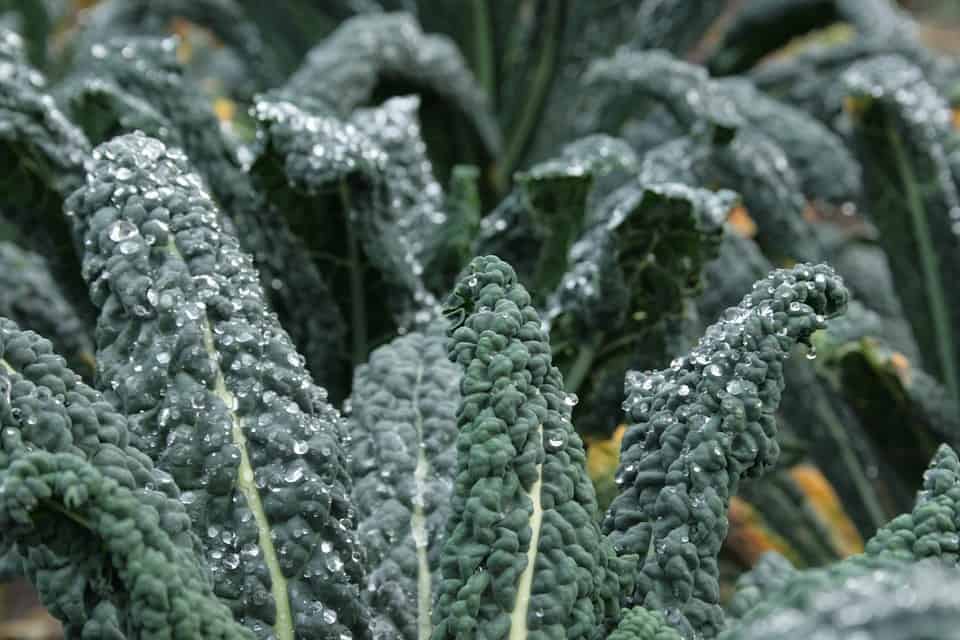So you’ve decided to start growing kale and… it’s actually growing! Now you want to start harvesting and enjoying the fruits of your labor. Harvesting kale is deceptively easy, and if you want to know how to pick kale so it keeps growing, you’ll be glad to know this is actually the best way to harvest kale to maximize yield as well.
If you want to harvest kale so it keeps growing, use the “cut-and-come-again” method of harvesting kale and other salad greens. Start from the bottom of the plant and cut off the lower leaves. You can pick as many leaves as you want off the plant as long as you don’t cut the tip of the plant where new leaves are growing. That said, it’s recommended to leave a couple extra leaves near the top so the plant can continue to get more energy to grow faster. Check your kale periodically and harvest more leaves as it grows.
On this page:
How Kale Grows
It might not be obvious when you see a big bushy kale plant, but like many other leafy green vegetables, kale naturally grows upward in a single stalk. The growing tip, technically called the apical meristem, continues putting out new leaves as the plant grows.
However, if you let kale grow to the end of the season and then harvest the whole plant, you’re actually losing yield because as kale grows, the lower leaves gradually start to turn yellow and die off. That’s why kale is a perfect cut-and-come-again vegetable.
If you’re growing other leafy vegetables, lettuce, spinach, Swiss chard, mustard, and other salad greens can be harvested the same way. Even head lettuce like Romaine can be harvested in a cut-and-come-again way.
When Is Kale Ready to Pick?
 Kale is ready to pick at any time. I’ve even eaten kale sprouts when I didn’t have any more room in the garden to transplant them. If you like baby kale, you can harvest the young leaves before they get large, or you can constrain your kale into a small or shallow pot so its size is naturally stunted. As long as the bottom leaves haven’t started turning yellow, you can pick it.
Kale is ready to pick at any time. I’ve even eaten kale sprouts when I didn’t have any more room in the garden to transplant them. If you like baby kale, you can harvest the young leaves before they get large, or you can constrain your kale into a small or shallow pot so its size is naturally stunted. As long as the bottom leaves haven’t started turning yellow, you can pick it.
One lesser-known tip: Kale actually starts to taste sweet after a frost, so when you are harvesting kale in early spring or late fall, enjoy an extra special treat! Many people say that’s the best time to enjoy kale.
Does Kale Grow Back After You Cut It?
Removing the lower leaves of your kale does not hurt the plant at all and will not hamper its growth unless you cut everything but the growing tip. But if you do accidentally cut off the growing tip, yes, kale will usually grow back with some side shoots. However, it will take much longer for the plant to recover before growth starts speeding up again. And sometimes it won’t grow back.
Think of it this way: kale’s leaves are like solar panels powering the plant’s growth. When you start off with a tiny seedling, it seems like it’s growing very slowly since it has those tiny solar calculator panels, but then a month passes and you suddenly have a huge solar array supporting its growth. Cutting off the growing tip is like turning it into a solar-powered calculator again.
This is why even commercial market gardens prefer to cut-and-come-again kale, as it maximizes yield and gives them continual harvests throughout the season.
How Many Times Can You Harvest Kale
Kale grows continuously and can even survive somewhat cold winters and continue growing in spring. So, theoretically, you could continue harvesting kale all year long.
Kale will keep growing until it bolts (produces a flower stalk). If you don’t intend to save the seeds, it’s recommended to cut off the flower buds to encourage continual leaf growth. But don’t throw those flower buds away! They are perfectly edible and are basically like broccoli.
There are some people who live in warmer climates that can keep pruning and harvesting from their kale plants for multiple years, but it’s recommended to start a new crop of kale from seed the following year.
